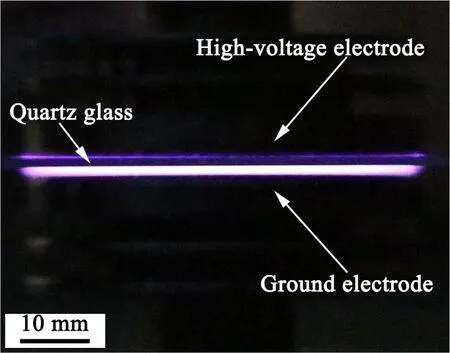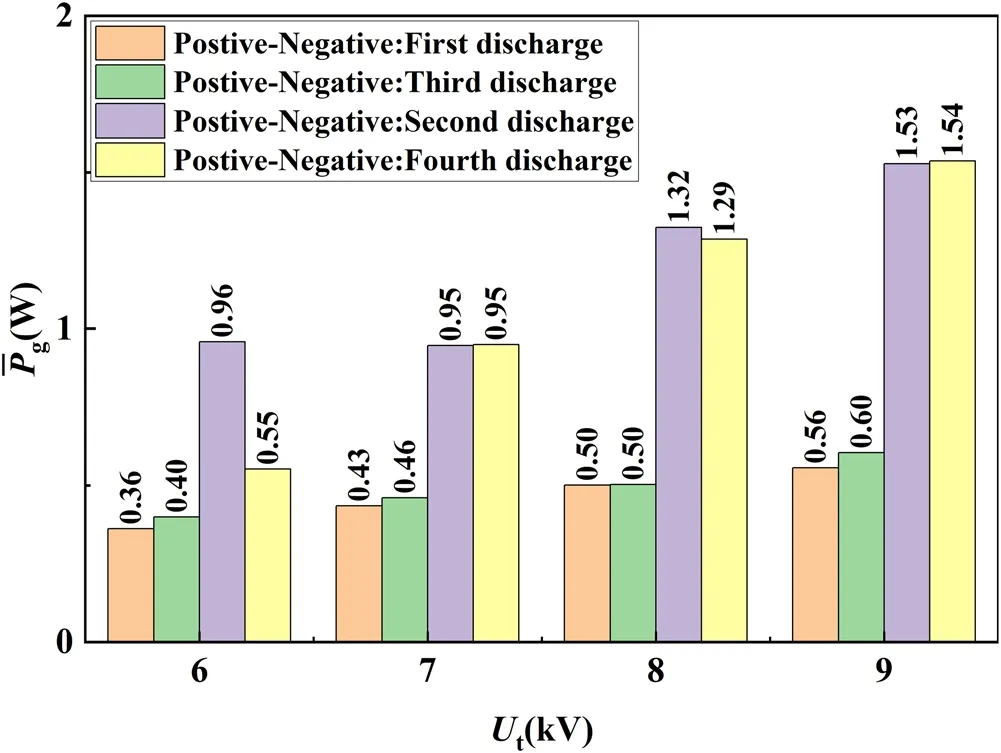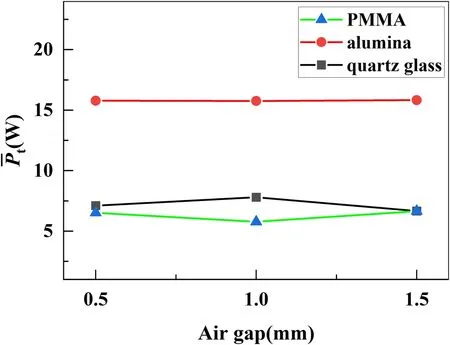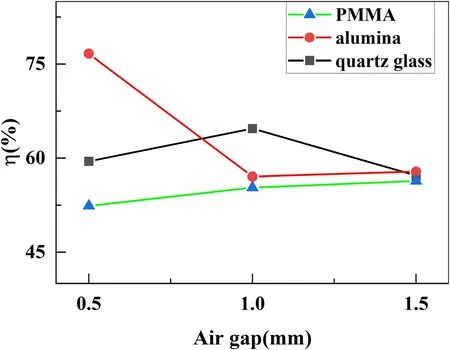Research on the characteristics of atmospheric air dielectric barrier discharge under different square wave pulse polarities
Song JIANG (姜松) , Lifei HUANG (黄利飞), Zhonghang WU (吴忠航),Yonggang WANG (王永刚), Zi LI (李孜) and Junfeng RAO (饶俊峰)
1Department of Electrical Engineering, School of Mechanical Engineering, University of Shanghai for Science and Technology, Shanghai 200093, People’s Republic of China
2 Department of Scientific Research, Shanghai University of Medicine and Health Sciences Affiliated Zhoupu Hospital, Shanghai 201318, People’s Republic of China
Abstract Energy efficiency limits the application of atmospheric pressure dielectric barrier discharge(DBD),such as air purification,water treatment and material surface modification.This article focuses on the electrical and optical effects of the DBD under three square wave pulses polarities-positive,negative and bipolar.The result shows that under the same voltage with the quartz glass medium,the discharge efficiency of bipolar polarity pulse is the highest due to the influence of deposited charge.With the increase of air gap distance from 0.5 to 1.5 mm,average power consumed by the discharge air gap and discharge efficiency decrease obviously under alumina, and increase, and then decrease under quartz glass and polymethyl methacrylate (PMMA).Through spectrum diagnosis, in the quartz glass medium, the vibration temperature is the highest under negative polarity pulse excitation.Under bipolar pulse, the vibration temperature does not change significantly with the change of air gap distance.For the three dielectric materials of quartz glass,alumina and PMMA, the molecular vibration temperature is the highest under the quartz glass medium with the same voltage.When the gap spacing, pulse polarity or dielectric material are changed, the rotational temperature does not change significantly.
Keywords: dielectric barrier discharge, pulse polarity, energy efficiency, molecular vibrational temperature, rotational temperature
1.Introduction
Dielectric barrier discharge (DBD) under atmospheric pressure can generate low-temperature plasma, which contains a lot of active particles [1].Therefore, it is widely used in material processing and synthesis [2], energy conversion [3],environmental governance [4], plasma medicine [5], agricultural food[6],seawater desalination and other fields[7,8].The parallel plate dielectric barrier reactor comprises parallel metal electrodes and dielectric, which is suitable for food sterilization and material surface modification [9, 10].In industrial applications, energy efficiency is a key issue.To improve the efficiency of DBD, researchers are committed to optimizing excitation power, dielectric materials and electrode shapes [11–13].
The traditional DBD is driven by AC power.The discharge overheating is serious and the energy efficiency is low[14].To improve the discharge efficiency, the pulsed power supply is used for DBD [15].Nakanoet alstudied the influence of AC voltage waveform on the characteristics of DBD.The steep voltage edge is more conducive to improving efficiency [16].Wanget alstudied the characteristics of DBD driven by AC and pulsed power supplies.The study showed that nanosecond pulsed coaxial DBD has higher instantaneous power deposition, lower total power consumption and higher energy efficiency in plasma,and the discharge is more uniform and stable [17].Yanget alstudied the characteristics of DBD under sine wave, square wave, symmetrical triangular wave,and positive and negative ramp waves.The study shows that the discharge efficiency is the highest under square wave driving voltage [18].DBD drived by the pulsed power supply has higher efficiency.In DBD related applications, the effects of pulse voltage,frequency and pulse width have been studied more.But the polarity of the pulse is less studied.Pechereauet alused numerical analysis methods to study the reignition of DBDs under different polarities.The results show that there are charges of opposite polarity deposited on the surface of the dielectric.Only when a negative voltage is applied to the electrodes, the reignition of the discharge was significantly affected[19].Yuanet alstudied the influence of different pulse polarities in the atmosphere on ozone production.It was found that the ozone generation efficiency is the highest under the positive polarity.Bipolar pulse could reduce the generation of nitrogen dioxide[20].Seiyaet alstudied the effects of positive and negative pulses on the discharge propagation and the density of OH,NO and O radicals,and found that the polarity of discharge affects the density of some active substances produced in the plasma jet[21].Muaffaqet alstudied the effect of streamer polarity on the reduction of nitric oxide.It was found that the intensity ratio of the first negative system of(391.4 nm, threshold energy 18 eV) to the second positive system of N2(337.1 nm, threshold energy 11 eV) depends on the flow polarity [22].Zhanget alstudied atmospheric air diffusion array-needle DBD excited by positive, negative and bipolar nanosecond pulses in large electrode gap.The study found that bipolar pulses were conducive to the DBD excitation, and could produce room temperature plasma with more uniform discharge and higher intensity [23].In previous studies,the short bell-shaped pulse and the nanosecond pulse with slow descending edge under different polarity are used for the comparative study of DBD polarity [20–23].Under the unipolar pulse, only one discharge occurs in a period, and the bipolar pulse occurs twice in a period.Under square wave pulse,the accumulated surface charge and space charge left by primary discharge are effectively utilized to form secondary discharge,which has more advantages.Therefore,the influence of square wave pulse polarity on the DBD is very important.
In this article, the high-voltage pulse power supply selfdesigned can generate three square wave pulses with different polarities-positive, negative and bipolar.On this basis, the electrical and optical characteristics of DBD have been studied.By measuring voltage and current combined with the equivalent model of DBD, the averaged power consumption in gap and discharge efficiency is analyzed.Then by using spectral diagnostic technology, the emission spectra under different pulse polarities, dielectric material and air gap distance were measured.Through the emission line of the second positive band of nitrogen molecule (C3Пu→B3Пg) by the emission spectrum, the vibration temperature and rotational temperature of nitrogen molecules (C3Пu) is also studied under different pulse polarities.The result shows that under the same applied voltage with quartz glass, the bipolar pulse discharge efficiency is the highest and the vibration temperature is the highest under negative polarity pulse excitation.Under the same applied voltage, with the change of air gap,for different media materials, the vibration temperature of nitrogen molecule is the highest in quartz glass medium.In alumina,the average power of discharge air gap is the highest,but the rotational temperature is kept at 300±100 K.
2.Experimental setup
The schematic diagram of the experimental device is shown in figure 1.It consists of a parallel plate DBD reactor,a high-voltage pulse power supply and an emission spectrum measurement system.
The DBD reactor is composed of a high-voltage electrode, a ground electrode and a dielectric.The main component of the electrode material is stainless steel.The diameter of electrode is 53 mm.Quartz glass, alumina and polymethyl methacrylate (PMMA) are selected as dielectric materials.The thickness of materials is 1 mm.During the experiment,the medium sticks to the upper electrode.The self-made highvoltage pulse power supply adopts Marx structure,which can output positive, negative and bipolar square wave voltage.The pulse voltage amplitude is adjustable from 0 to 10 kV and the pulse width is adjustable from 1 to 50 μs.The frequency of the voltage is 1 kHz.Three typical voltage output waveforms are shown in figure 2.The voltage and current are measured by a high-voltage probe (Tektronix P6015 A,bandwidth 75 MHz) and a current probe (Pearson 2100,20 MHz).The emission spectrum is directly measured by a fiber optic spectrometer (Avantes AvaSpec Mini 3648).The discharge photos are taken by Canon camera(Canon EOS 5D Mark III).
3.Experimental results and discussion
3.1.The analysis of discharge process
Discharge image at bipolar pulse peak voltage of 9 kV,pulse repetition rate of 1000 Hz and air gap distance of 0.5 mm is shown in figure 3, captured by the Canon EOS 5D Mark III digital camera with 1/30 s exposure time, F3.2 aperture and ISO 20000 sensitivity.It can be seen from the discharge picture that the discharge is relatively uniform.The average power and energy efficiency of the discharge air gap is calculated by the classical theoretical calculation method.The equivalent circuit model of DBD is shown in figure 4.Cdrepresents the capacitance of dielectric layer andCgrepresents the equivalent capacitance of air gap.The calculation process can be found in the relevant literature[24].Secondary discharge under unipolar pulses does not consume the energy of the external circuit at the same time, and the required energy is provided by the accumulated surface and space charges left by the primary discharge [24, 25]


WhereUtis the voltage applied to the reactor;Itis the current flowing through the reactor;Ptis the instantaneous power of DBD;Ugis the voltage on the air gap;Igis the plasma current flowing through the air gap;Pgis the instantaneous power of discharge air gap;Udis the voltage on the medium;Idis the current flowing through the medium;Pdis the instantaneous power of medium;Pgis the average power consumed by the discharge air gap;Pdis the average power consumed by medium;Ptis the average power consumed by reactor andηis the DBD energy efficiency.
With the peak voltage of 8 kV, the air gap distance of 0.5 mm,and the dielectric material of quartz glass,the voltage and current applied to the reactor,Ug,Ig,Pg,PdandPtcalculated under the unipolar pulse are shown in figures 5 and 6.There are two discharges in one pulse period, which correspond to the rising and falling edges of the voltage.Under unipolar positive pulse and negative pulse, the peak value of the first discharge current is close, and the positive pulse of the second discharge current is greater than the negative pulse.Secondary discharge is mainly due to deposition charge, the cause of this phenomenon may be related to deposition charge.As shown in figure 5(b),when the unipolar positive pulse first discharges, the currentIgis the smallest and the air gap voltageUgis the largest.But in the second discharge, when the currentIgis maximum, the air gap voltageUgis also maximum.Therefore, the instantaneous power of discharge air gapPgin second discharge is greater than that in first discharge.Under unipolar negative pulse,UgandIgare shown in figure 6(b),UgandIgare opposite to unipolar positive pulses.The corresponding data under bipolar voltage are shown in figures 7(a) and (b).There are four discharges in one cycle.Under bipolar pulse, the discharge current is significantly larger than that under unipolar pulse, because the discharge voltage is lower and the discharge is more intense under bipolar pulse[20].Under bipolar pulse, the occurrence of the second and fourth discharges is mainly caused by the deposition charge, and the required energy is mainly provided by the accumulated surface and space charges left by the first and third discharges.Similar to unipolar pulse,the second discharge and the fourth discharge do not consume the energy of the external circuit at the same time.
Under unipolar pulse, the average air gap discharge powerPgof the first discharge and the second discharge is shown in figure 8.At low voltage, the average powerPgof the first discharge is less than that of the second discharge,and with the increase of voltage,the average powerPgof the second discharge is greater than that of the first discharge.In parallel plate DBD reactor, high-voltage electrode covers medium.The rising time and falling time of the positive polarity pulse are 160 and 133 ns from figure 5(a), and those of the negative polarity pulse are 248 and 137 ns from figure 6(a).The faster the rising edge of the voltage, the higher the discharge power and discharge efficiency[16].The energy of the second discharge is provided by the first discharge, so the size of the second discharge is related to the deposition charge and the time of the rise and fall edges.As shown in figure 9,under bipolar pulse,the average discharge powerPgof the second discharge gap is the first discharge,and the fourth discharge power is greater than the third discharge power.It is mainly due to the low bipolar breakdown voltage and more deposition charges than unipolar.
With the voltage change, the average power input to the reactorPtis shown in figure 10 under pulse voltages of different polarities.Whether applying the positive, negative or bipolar pulse voltage, theinput to the dielectric barrier reactor also increases as the voltage increases.Obviously,the bipolar power is the most.The average power consumed by the discharge air gapcalculated is shown in figure 11.ThePgof bipolar pulse is still the highest.The curve of DBD energy efficiencyηwith voltage is shown in figure 12.Under the same voltage,the efficiency of the bipolar polarity pulse is the highest, and the negative polarity pulse is the lowest.When the applied voltage is 9 kV, the discharge energy efficiencies of positive pulse,bipolar pulse and negative pulse are 52.8%, 59.5%, 49.6% respectively.
It can be seen from figure 12 that with the change of voltage, the average power consumed by the reactor under bipolar pulse is about twice that under unipolar pulse.Through the analysis of the average power consumption of the rising edge and falling air gap of the pulse,it can be seen that under the bipolar pulse, due to the influence of the deposition charge, the average power of the air gap of the bipolar positive pulse is greater than that of the unipolar positive pulse, and the power of the bipolar negative pulse is greater than that of the unipolar negative pulse.So bipolar pulse discharge efficiency is greater than unipolar pulse.The discharge efficiency under bipolar square wave pulse is greater than that under unipolar pulse.After the second discharge with bipolar positive pulse, some deposition charges are still retained to participate in the third discharge.
3.2.The effect of dielectric material and air gap distance on discharge
Under the bipolar voltage of 9 kV and three different dielectric (quartz glass, alumina and PMMA), the average power input to the reactoris shown in figure 13 with the change of air gap distance.Theof three different dielectric material is shown in figure 14.The energy efficiencyηof DBD with the air gap distance is shown in figure 15.The average power consumed by the discharge air gap and discharge efficiency decrease obviously under alumina, and increase and then decrease under quartz glass and PMMA.
For parallel plate DBD reactors, the electrode configuration is known and can be calculated by the following equation:

whereddis the thickness of the dielectric barrier;dgis the thickness of the discharge gap;ε0is the permittivity of the air gap; εris the dielectric constant of the used dielectric barrier material andCeqis the equivalent capacitance of DBD reactor.
Geometry parameters of the reactor(in section 2)and the relative permittivity of quartz glass, alumina and PMMA are shown in table 1.It can be seen from the above formula that the larger the relative dielectric constant, the larger the dielectric layer capacitance,the higher the voltage on the air gap of the reactor, and the larger the air gap spacing, the smaller the air gap capacitance.Due to the dielectric capacitance is different, so different dielectric, the best discharge efficiency of air gap distance is different.
From the figures 13, 14 and table 1, the relative permittivity of alumina medium is the largest, and the average power and air gap power of the dielectric barrier reactor are the largest.The relative dielectric constant of PMMA is small,so the average power and air gap power are the smallest.The influence of dielectric materials on DBD efficiency mainly depends on the relative dielectric constant and dielectric loss factors.From the figure 15, the higher the relative dielectric constant is, the higher the DBD efficiency is when the discharge gap distance is small.
3.3.The spectrum characteristics of discharge
The vibration temperature reflects the electron temperature in the plasma to a certain extent.Under the voltage of 9 kV with different pulse polarities and quartz glass dielectric, the typical spectrum measured is shown in figure 16.From the emission line of the second positive band of nitrogen molecule (C3Пu→B3Пg), the vibration temperature (Tvib) and rotation temperature(Trot)of N2(C,υ)is calculated.SPECAIR software is used to simulate the spectrum, and the plasma parameters are obtained by comparing the simulated spectrum and the experimental spectrum [26].The slit function is the trapezoid of 0.66 nm on the substrate and 0.22 nm on the top.The vibration temperature and rotation temperature were determined by fitting SPECAIR spectrum in the range of 350–410 nm.
An example of a best fit is presented in figure 17 achieved with values ofTvib=3000 K andTrot=290 K.The estimated value of the error bar is obtained as the range of the fitting parameter values.According to our best fitting standard,the fitting parameter values will still produce acceptable fitting without considering the additional influence of physical errors.
Under the quartz glass dielectric and air gap distance of 0.5 mm, the vibration temperature and rotational temperature ofnitrogen molecules with different pulse polarities is shown in figure 18.

Table 1.Typical parameters of quartz glass, alumina and polymethyl methacrylate.
When the voltage is 8 kV,the nitrogen molecular vibration temperature under positive, negative and bipolar polarities is 3000±100 K, 3100±100 K and 2900±100 K respectively, and all the rotational temperature under positive, negative and bipolar polarities is 290±100 K.From the overall trend, the vibration temperature and rotational temperature of nitrogen molecules is the highest under the excitation of the positive polarity pulse.Figure 18 shows that the polarity of square pulse has a significant effect on the plasma vibration temperature, and the molecular vibration temperature is the highest under negative pulse.Whether bipolar pulse or unipolar pulse(positive pulse or negative pulse),the gas temperature of plasma has no obvious change with the increase of pulse peak voltage, which is roughly maintained in the range of 300±100 K.The results show that no matter what the polarity of the driving pulse is, the heating effect of the plasma is not obvious.The reason is that electrons can obtain the maximum acceleration in the average free path in the pulse electric field,while the displacement of gas molecules and ions is very small in the short pulse duration, which means that the Joule heat effect is not obvious, so the use of high-voltage pulse power supply can obtain higher energy efficiency.

Figure 1.Schematics of the experimental setup.

Figure 2.The output voltage waveforms of high-voltage pulse power supply.(a) Positive pulse, (b) negative pulse, (c) bipolar pulse.

Figure 3.Image of DBD under bipolar square wave pulse at 9 kV voltage, 1 kHz pulse repetition rate, and 0.5 mm electrode gap distance.

Figure 4.Equivalent circuit of parallel plate dielectric barrier discharge under high-voltage electrode dielectric coverage.

Figure 5.The (a) voltage–current waveforms and calculated (b) Ug,Ig, (c) Pg, Pd and Pt of the parallel plate DBD reactor with quartz glass at 8 kV positive square pulse and 0.5 mm electrode gap distance.

Figure 6.The (a) voltage–current waveforms and calculated (b) Ug,Ig, (c) Pg, Pd and Pt of the parallel plate DBD reactor with quartz glass at 8 kV negative square pulse and 0.5 mm electrode gap distance.

Figure 7.The (a) voltage–current waveforms and calculated (b) Pg, Pd and Pt of the parallel plate DBD reactor with quartz glass at 8 kV bipolar square pulse and 0.5 mm electrode gap distance.

Figure 8.The variation of the first and second discharge power under positive and negative square pulses.

Figure 9.The four discharges power under bipolar square pulse.

Figure 10.Change of Pt for varies voltage.

Figure 11.Change of Pg for varies voltage.

Figure 12.The energy efficiency for varies voltage.

Figure 13.Change of Pt with gap distance.

Figure 14.Change of Pg with gap distance.

Figure 15.The energy efficiency for varies gap distance.

Figure 16.Emission spectra in the range of 350–410 nm of air dielectric barrier discharge under postive,negative and bipolar pulse at 9 kV.

Figure 17.The simulated spectra and experimental emission spectra with quartz glass at 7 kV bipolar square pulse and 0.5 mm air gap distance.

Figure 18.Variations of (a) vibration temperature and (b) rotational temperature under different pulse polarities.

Figure 19.Variations of (a) vibration temperature and (b) rotational temperature under different dielectric materials.
With the bipolar pulse voltage of 9 kV, the vibration temperature and rotational temperature of nitrogen molecules with different dielectric materials are shown in figure 19.It can be seen from figure 19 that under bipolar pulse, the rotational temperature and vibration temperature do not change significantly with the change of air gap distance, and the dielectric material has an effect on the molecular vibration temperature.The rotational temperature has no obvious change regardless of the change of air gap spacing and dielectric material.The material has no significant effect on the rotational temperature, possibly due to the short discharge time.
4.Conclusions
This work studies the power and efficiency of DBD under different pulse polarities.At the same time, according to the measured emission spectrum, the vibration temperature of N2(C,υ) is calculated using the intensity of the emission spectrum of the vibration band sequence.
No matter what polarity voltage is applied, with the increase of voltage in quartz glass medium,the average power consumed by reactor and the average power consumed by the discharge gap also increases.Under the same applied voltage,the bipolar pulse discharge efficiency and average power consumed by the discharge air gap are the highest, the positive pulse discharge efficiency is the second,and the negative pulse nitrogen molecular vibration temperature is the highest.Whether applied positive, negative or bipolar pulses, the rotational temperature of nitrogen molecules did not change significantly.For three different dielectric materials (quartz glass,alumina and PMMA)with the same bipolar voltage,the nitrogen molecular vibration temperature is the highest under quartz glass.Under the alumina medium, the average power consumed by the discharge air gap is the highest.When the gap spacing and dielectric material are changed,the rotational temperature does not change significantly.
Acknowledgments
This work is supported by Shanghai Sailing Program (No.19YF1435000) and National Natural Science Foundation of China (Nos.51707122 and 12005128).
ORCID iDs
 Plasma Science and Technology2021年12期
Plasma Science and Technology2021年12期
- Plasma Science and Technology的其它文章
- A study on nuclear analysis of the divertor region of the CFETR
- Evaluation of gases’ molecular abundance ratio by fiber-optic laser-induced breakdown spectroscopy with a metal-assisted method
- Thermophysical properties of pure gases and mixtures at temperatures of 300–30 000K and atmospheric pressure:thermodynamic properties and solution of equilibrium compositions
- Plasma treatment for enhancement of the sorption capacity of carbon fabric
- Parametric study of high-frequency characteristics of plasma synthetic jet actuator
- Energy properties and spatial plume profile of ionic liquid ion sources based on an array of porous metal strips
